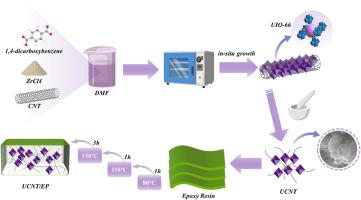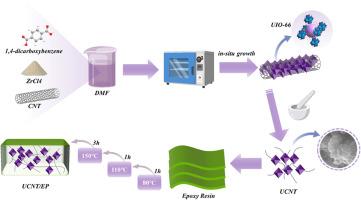Enhancement of the thermal conductivity and mechanical properties of low-k epoxy resin by UIO-66@CNT nanocomposites
IF 4.5
2区 化学
Q2 POLYMER SCIENCE
引用次数: 0
Abstract
Epoxy resin (EP) is commonly used to reduce the dielectric constant and dielectric loss by incorporating appropriate fillers, addressing issues such as slow signal transmission and signal delay in smart terminals employed in ultra-large-scale integrated (ULSI) circuits under harsh operating conditions. Ensuring excellent mechanical properties and thermal conductivity is also essential to extending the service life of these components. In this work, the effects of carbon nanotubes (CNTs) modified through the in-situ growth of the two-dimensional hybrid material UIO-66 on the epoxy resin matrix (UCNT/EP) in terms of thermal, mechanical, and dielectric properties were investigated. The results indicated that the dielectric constant of the 1.0 wt% UCNT/EP composite decreased by 4.9 % at 102 Hz compared with the original matrix, while the dielectric loss remained below 0.025 in the frequency range of 102–107 Hz. At a filler content of 2.0 wt%, the bending strength and flexural modulus of the composite reached 142.7 MPa and 3356.1 MPa, respectively. Additionally, the thermal conductivity of the composites exhibited a substantial increase of 226 %, and the char formation rate was improved at 700 °C.


UIO-66@CNT纳米复合材料增强低k环氧树脂的导热性和力学性能
环氧树脂(EP)通常用于通过加入适当的填料来降低介电常数和介电损耗,解决超大规模集成电路(ULSI)中使用的智能终端在恶劣工作条件下信号传输缓慢和信号延迟等问题。确保优异的机械性能和导热性对于延长这些部件的使用寿命也至关重要。本文研究了原位生长二维杂化材料uuo -66改性后的碳纳米管(CNTs)在环氧树脂基体(UCNT/EP)上的热、力学和介电性能的影响。结果表明,1.0 wt.%的UCNT/EP复合材料在102 Hz频率下的介电常数比原基体降低了4.9%,而在102 ~ 107 Hz频率范围内的介电损耗保持在0.025以下。当填料含量为2.0 wt.%时,复合材料的抗弯强度和抗弯模量分别达到142.7 MPa和3356.1 MPa。此外,复合材料的导热系数大幅提高了226%,在700℃时炭的形成速率也有所提高。
本文章由计算机程序翻译,如有差异,请以英文原文为准。
求助全文
约1分钟内获得全文
求助全文
来源期刊

Polymer
化学-高分子科学
CiteScore
7.90
自引率
8.70%
发文量
959
审稿时长
32 days
期刊介绍:
Polymer is an interdisciplinary journal dedicated to publishing innovative and significant advances in Polymer Physics, Chemistry and Technology. We welcome submissions on polymer hybrids, nanocomposites, characterisation and self-assembly. Polymer also publishes work on the technological application of polymers in energy and optoelectronics.
The main scope is covered but not limited to the following core areas:
Polymer Materials
Nanocomposites and hybrid nanomaterials
Polymer blends, films, fibres, networks and porous materials
Physical Characterization
Characterisation, modelling and simulation* of molecular and materials properties in bulk, solution, and thin films
Polymer Engineering
Advanced multiscale processing methods
Polymer Synthesis, Modification and Self-assembly
Including designer polymer architectures, mechanisms and kinetics, and supramolecular polymerization
Technological Applications
Polymers for energy generation and storage
Polymer membranes for separation technology
Polymers for opto- and microelectronics.
 求助内容:
求助内容: 应助结果提醒方式:
应助结果提醒方式:


